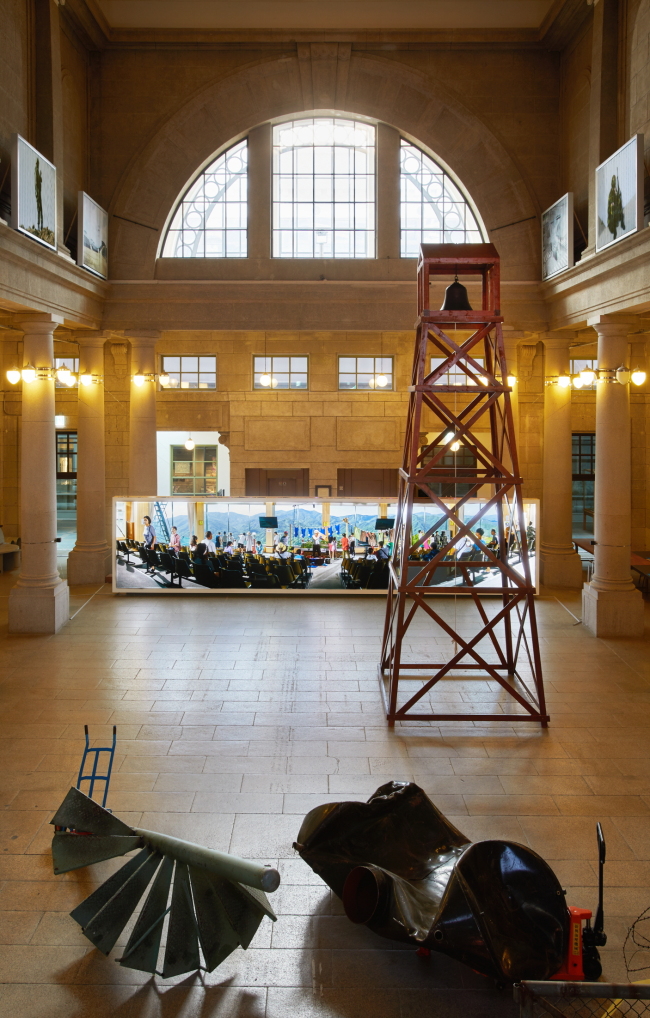The exhibition “DMZ,” dedicated to introducing works of art and projects looking into the Demilitarized Zone between the two Koreas, will be held at Culture Station Seoul 284, starting Thursday.
“It is meaningful to hold such an exhibition here in this train station-turned exhibition space, which originally was the railway station of Gyeongui Line that used to stretch between here and (the North Korean city of) Sinuiju,” officials from Culture Station Seoul 284 said at a press conference held Wednesday at the arts and cultural complex.
 |
Installation view of main hall of “DMZ” (Yonhap) |
The latest exhibition is in the line of “The Real DMZ Project,” which Kim Sun-jung -- curator and president of the Gwangju Biennale Foundation -- first formulated in 2011. To date, this contemporary art project has continued to feature works based on research conducted on areas around the DMZ as part of attempts to address the reality of division between the two Koreas.
“This is the first time to bring the DMZ project to Seoul,” Kim said during a press conference. “The exhibition here comprises works based on recent research into the region, along with some works previously introduced.”
 |
Kim Sun-jung, curator and president of the Gwangju Biennale Foundation, speaks during a press conference held held Wednesday at the arts and cultural complex. (Yonhap) |
Kim explained that works of art and archival materials are installed accordingly with the temporal and spatial frameworks or criteria the exhibition devised to arrange them.
The central hall works as the main space, where the two intersect, Kim said. This ground point of the exhibition presents artworks that show the “now” of the DMZ area.
The main hall includes works by Ahn Kyu-chul, Jung Yeon-doo and Back Seung-woo, among others.
Ahn’s 2019 work “Peace Bell” is a large tower-shaped installation with a bell atop it forged with metal from border guard posts that were recently taken down. The work rings at certain intervals.
Jung’s photography work titled “Eulji Theater” (2019) was taken in Yanggu, Gangwon Province, which borders the North. The work was selected among many photos from observatories lined up from the western front to the eastern front. The photography works, which Jung has theatricalized, portray the distant landscape that embodies history and the narratives that came after division.
The section on the right side of the main hall has been conceived as a space to introduce proposals for the future of the border area created by artists, designers and architects. The section include “what-can-it-become” proposals by acclaimed cultural figures in Korea, such as Seung Hyo-sang Park Kyong, Paik Nam-june and Bahc Yi-so, among others. Also on view is Paul Virilio’s 1988 untitled proposal to construct an inaccessible airport inside the DMZ.
 |
Lee Bul explains her “Study for Aubade V” at a press conference Wednesday at the Culture Station Seoul 284. (Yonhap) |
The section also showcases proposals made by artist Lee Bul. One of the three proposals by Lee, “Study for Aubade V” (2019), is a working model of an upcoming piece. The work, which is in line with her “Aubade” series, will later turn into a roughly 4-meter-high structure made with metal taken from the recently taken down guard posts. This miniaturized installation work has seven buttress-like wings with various images that may come in showy colors when fully developed, the artist said.
To the left of the main hall are rooms dedicated to feature works exploring lives inside the DMZ -- those of soldiers and of the residents inside the Civilian Control Zone. Included in the section are Park Jong-woo’s documentary videos taken between 2009 and 2017, Kwon Ha-youn’s “489 Years” (2015), Kim Joon’s “Mixed Signals” (2015-19) and “Freedom Village” (2017-19) by Moon Kyung-won and Jeon Joon-ho.
On the second floor, archival works are displayed. Archive materials that deal with the DMZ’s history include audio works of sounds and noises collected from the border area. The second floor also presents works by painters and photographers that have captured the remote goings-on beyond the boundary.
The long west hallway behind the main hall features the DMZ’s ecological profile, with many rare plants and wild animals, in addition to a collection of books on the border area.
The exhibition with works by some 50 artists from here and abroad runs through May 6.
By Shim Woo-hyun (
ws@heraldcorp.com)







![[Exclusive] Hyundai Mobis eyes closer ties with BYD](http://res.heraldm.com/phpwas/restmb_idxmake.php?idx=644&simg=/content/image/2024/11/25/20241125050044_0.jpg)
![[Herald Review] 'Gangnam B-Side' combines social realism with masterful suspense, performance](http://res.heraldm.com/phpwas/restmb_idxmake.php?idx=644&simg=/content/image/2024/11/25/20241125050072_0.jpg)

